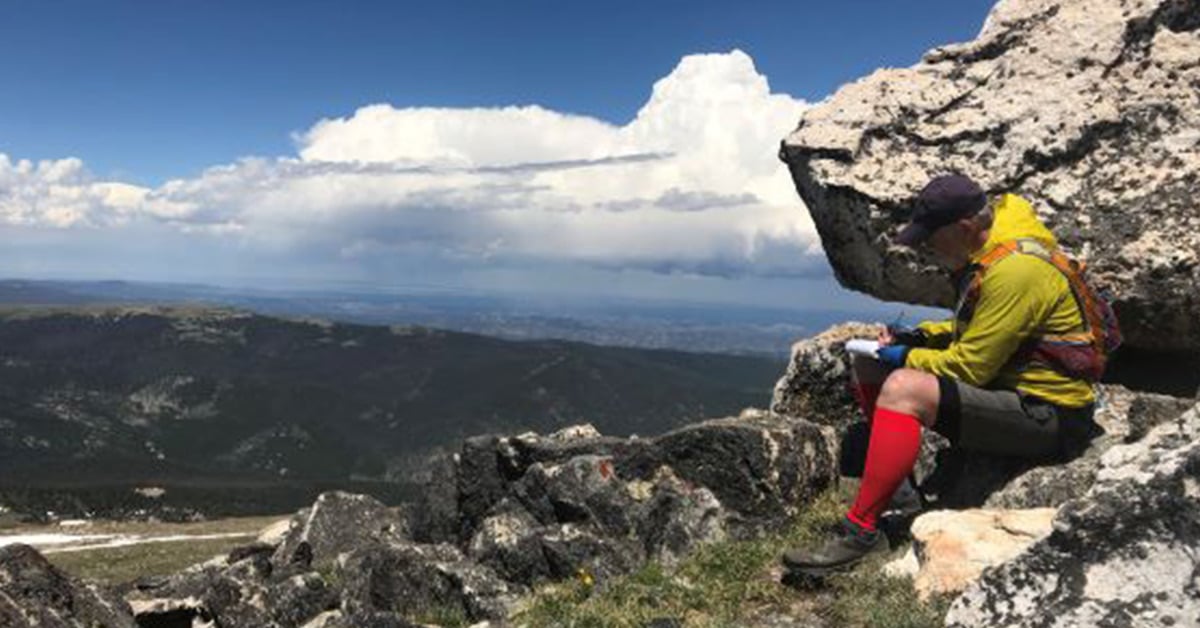Not, I’ll not, carrion comfort, Despair, not feast on thee;
Not untwist — slack they may be — these last strands of man
In me ór, most weary, cry I can no more. I can;
Can something, hope, wish day come, not choose not to be.
But ah, but O thou terrible, why wouldst thou rude on me
Thy wring-world right foot rock? lay a lionlimb against me? scan
With darksome devouring eyes my bruisèd bones? and fan,
O in turns of tempest, me heaped there; me frantic to avoid thee and flee?
Why? That my chaff might fly; my grain lie, sheer and clear.
Nay in all that toil, that coil, since (seems) I kissed the rod,
Hand rather, my heart lo! lapped strength, stole joy, would laugh, chéer.
Cheer whom though? the hero whose heaven-handling flung me, fóot tród
Me? or me that fought him? O which one? is it each one? That night, that year
Of now done darkness I wretch lay wrestling with (my God!) my God.
~ GM Hopkins
The heat and humidity of the Georgia summer have settled in, and for trail
runners, this means getting out early, and packing plenty of water. Today, I
was late getting started and the summer pattern of heavy evening
thunderstorms has been in place for weeks. It’s hot, and humid, weather
you can wear, as we say down south. As a Georgia native accustomed to
two-a-day football practices early on (beginning in August) back in the
70’s, I like to think I’ve got this. Freed up from the rigorous and welldefined structure of the gridiron and let loose on the trails, I am in some
ways “younger” and more playful. As Bob Dylan said so well, “I was so
much older then…I’m younger than that now.” And yet, the years have
taken their toll on me.
Today was a tough day. In anticipation of gathering in northern Colorado
next month with dear friends from grad school at Vanderbilt, I’m getting in
as much vertical trail running as possible. On good day, locally, this means
P a g e | 2
1,500’-2,000’ of elevation gain over 7-10 miles of hard trail running. On a
hard day, I may get in 3,000’ feet of elevation gain. It’s not enough, as the
all-day trail run up to Comanche Peak in the Northern Rockies will be
more than 7,000’ of elevation gain over 10-12 hours.
Still, combined with the heat index of a Georgia summer now regularly in
the 90’s, these climbs are challenging. Did I mention I’m not getting any
younger? I’m aware this summer of the difference between the runner I
was at, say, age 60, and what I am now able to do only with more effort.
And this, after almost two years of increased training. The good news is
that recent research has shown that training under these conditions at or
near sea level can increase one’s VO2 max in ways similar to training at
altitude.1 The bad news is that as we get older, running in heat and
humidity takes its toll. I was so much younger then, I’m older than that
now.2
After a couple of hours of running, including up the mountain, I realized I
needed to stop and walk. Then sit. And drink. A climb that even 5 years
ago would have been manageable now had me facing my human finitude
and mortality in an experiential moment of anaerobic truth. Fifteen
minutes later, slowly coming back to myself, I began to descend Little
Kennesaw, a technical and rocky trail leading down to Pigeon Hill, and
eventually to my car. On Pigeon Hill there’s another technical section with
huge granite boulders deposited approximately one billion to 300 million
years ago, through a series of mountain building events or “Orogeny.” In
geologic time this period is known as the late Precambrian to the early
1
The Benefits of Running in the Summer | by Jennifer Geer | Runner’s Life | Medium
2
Study: Older Athletes Struggle More in the Heat | Runner’s World (runnersworld.com)
P a g e | 3
Paleozoic.3 We affectionately refer to this section as the Rock Garden, and
indeed, the variety of colors, shapes, and sizes of boulders and the sweet
granite single-track is a joy.
As I arrived at Pigeon Hill, I came upon two Turkey Vultures (Cathartes
aura) drinking from a natural bowl in the granite slick rock trail filled with
water from yesterday’s rains. I slowed to a walk, and slowly approached,
pausing to take photos. They eyed me in a disinterested way, continued to
drink, and after a few minutes flew to a nearby dead pine tree, where they
could better size me up, and, so it seemed, make a determination about my
current status. As our group of trail runners says, “conditions may vary.”
My current condition was not ideal.
Vultures are beautiful creatures. And they are distinctive in ways both
mysterious and life-giving. Vultures scavenge in carrion. They are among
the few species for whom this is the case, and their stomach acid, with a
PH@ 1.0, is exceptionally corrosive. This allows them to safely digest
carcasses infected with Botulinum toxin, cholera bacteria, even anthrax, in
so doing removing these from the environment. As I watched these
3
siteb_nbl (nps.gov)
P a g e | 4
fascinating birds—and they watched me—I realized I may have more in
common with them than I knew. But, I’ll say more about that in a moment.
For those interested in mythology, religion, and ancient cultures vultures
are a rich source of information. In Egypt, the goddess Nekhbet was
depicted as a vulture, and they were revered in Egyptian culture for their
ability to transform death, in the form of carrion, into life. Mesoamerican
narratives contain myths, legends, trickster-stories and fables involving
vultures. In Vajrayana Buddhism vultures are essential to the sky burial
narratives, where bodies are taken to high altitudes and left to the vultures
and the vicissitudes of nature. I am drawn to this narrative ritual.
In Mumbai, India, Parsis, who practice Zoroastrianism, created “Towers of
Silence,” open-air auditoriums designed for vultures to devour human
carcasses. Writing in the New York Times, Gardiner Harris notes that
“India once contained an estimated 400 million vultures, and in a culture
which forbids the slaughter of cattle, when cattle died vultures left behind
only skin for leather merchants and bones for collection. But then came
Diclofenac, a common painkiller widely used in hospitals to lessen the pain
of the dying. Marketed under names like Voltaren, it is similar to the
medicines found in Advil and Aleve; in 1993 its use in India was approved
in cattle. Soon after, vultures began dying in huge numbers because the
drug causes them to suffer irreversible kidney failure.” Diclofenac’s
veterinarian use has since been banned, which may finally be having an
P a g e | 5
effect. A recent study found that for the first time since the drug’s
introduction, India’s vulture population did not decline over the past year.4
Back home in Georgia, I imagine my own sky burial here on the slick-rock
granite at Pigeon Hill, as suitable as any way for a trail runner to go out. I
note that the vultures are ensconced on the limbs of a dead pine, lost with
many other trees on this exposed section of the escarpment to extreme
drought and heat several years ago. Now, in the spaces opened up by the
absence of the former canopy, new growth flourishes, a liminal ecosystem
in transition, seeking resilience in a new homeostasis. Roosting
momentarily on the dead pine tree, vultures, too, are in the transformation
business, giving new life to old forms, life amidst death, and in so doing
they find meaning in the most difficult of narratives.
Today, however, is apparently not my day for a sky burial. In my liminal
vulture and heat induced reverie I find myself somehow restored, and I
may live to run another day. As I head down Pigeon Hill to my car, I
consider my work in the classroom, and the clinic, and the transitional
nature of both; each expressions of the priesthood, itself given life in the
transitional space at the altar. And I think of pastoral theology, a discipline
borne of in-between spaces, seeking meaning, healing, reconciliation,
guiding, and sustaining where hope may sometimes seem lost. I think of
venturing, by virtue of my work, into messy spaces of brokenness, and I
recognize in my new vulture friends, kindred spirits who are, like myself,
denizens of hopeful spaces all appearances, at times, to the contrary. There
is good, difficult, transformational work to be done in those spaces.
In his poem Carrion Comfort, GM Hopkins chooses a rejection of despair,
that carrion comfort which, while acknowledged, is not the final word. To
“feast” on despair, Hopkins seems to suggest, would be like consuming
something dead and vile, something like the carrion vultures paradoxically
turn into life. Nor will the poet unravel his “last strands” of humanity by
giving up hope, though he is close to hopelessness. Hopkins wrote this
sonnet at a time when he had just emerged from a long period of
depression and, yes, was close to despair. The poem seems designed to
surprise us with these contrasts of hope and despair, and to seek meaning-
4
Cultivating Vultures to Restore a Mumbai Ritual – The New York Times (nytimes.com)
P a g e | 6
making amidst the “carrion comfort,” even as he comes to terms with the
existential reality of his own spiritual struggle, and as the very context of
carrion comfort itself is transformed into a kind of hope, however fragile.
He makes the assertion “I can,” and then explores what that assertion
might mean, what basic action or spiritual gesture might serve to
counteract despair: doing “something” that expresses hope, even if it is to
“not choose not to be.” One commentary suggests that, having skirted the
pit of despair, the poet questions God about the suffering that has drawn
him so close to hopelessness. He asks why God would send him so close to
despair. These questions are the ones we ask, or not, in the service of
finding meaning, often in those moments of awareness that we are spiritual
creatures in an embodied, finite world.
In his novel “The Moviegoer,” Walker Percy, paraphrasing Kierkegaard’s
“Knight of Faith,” writes that “The search is what anyone would undertake
if he were not sunk in the everydayness of his own life. To become aware of
the possibility of the search is to be onto something. Not to be onto
something is to be in despair.” Perhaps Percy’s protagonist Binx Bolling,
like Hopkins, and like my vulture companions, can paradoxically find
transformative hope precisely in those places where hope seems lost, and
despair seems the only reasonable response.
Indeed, perhaps as we, like Hopkins, emerge from a season of challenges,
loss, and languishing in our post-pandemic world, we can see glimpses of
renewal, resilience, and transformation. That “year of now done darkness”
may find us wrestling with our finitude, and mortality, and Creator, with a
renewed hopefulness. I give thanks to my vulture sisters and brothers,
sentinels in spaces of transformation, kindred spirits, and companions on
the way. That’s enough to get me back out for another run tomorrow. The
important thing is to keep moving. Who knows what—or who—we may
find on the trails?
Keep Reading
Want more? Here are some other blog posts you might be interested in.







